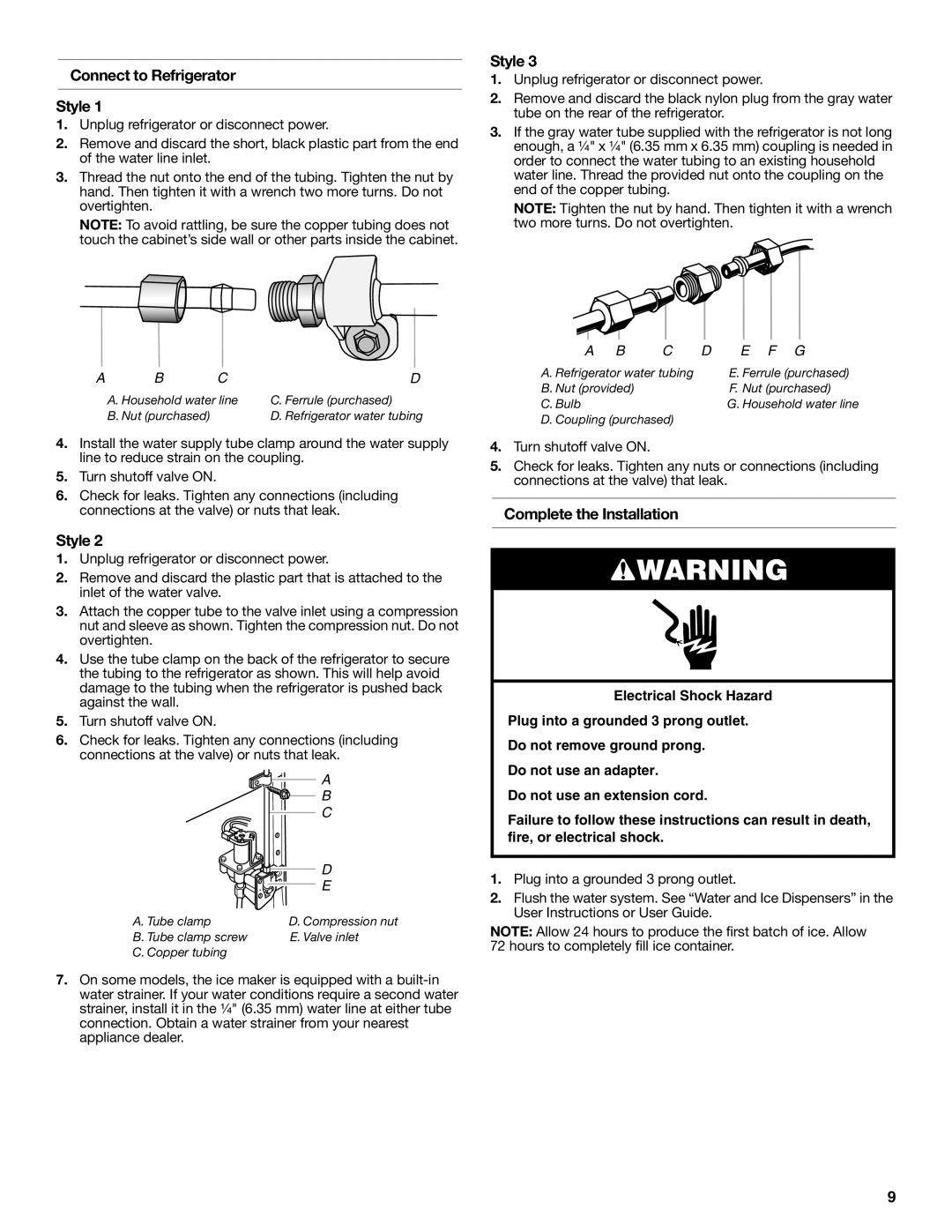
Connect to Refrigerator
Style 1
1.Unplug refrigerator or disconnect power.
2.Remove and discard the short, black plastic part from the end of the water line inlet.
3.Thread the nut onto the end of the tubing. Tighten the nut by hand. Then tighten it with a wrench two more turns. Do not overtighten.
NOTE: To avoid rattling, be sure the copper tubing does not touch the cabinet’s side wall or other parts inside the cabinet.
Style 3
1.Unplug refrigerator or disconnect power.
2.Remove and discard the black nylon plug from the gray water tube on the rear of the refrigerator.
3.If the gray water tube supplied with the refrigerator is not long enough, a ¹⁄₄" x ¹⁄₄" (6.35 mm x 6.35 mm) coupling is needed in order to connect the water tubing to an existing household water line. Thread the provided nut onto the coupling on the end of the copper tubing.
NOTE: Tighten the nut by hand. Then tighten it with a wrench two more turns. Do not overtighten.
A | B | C | D |
| A. Household water line | C. Ferrule (purchased) | |
| B. Nut (purchased) |
| D. Refrigerator water tubing |
4.Install the water supply tube clamp around the water supply line to reduce strain on the coupling.
5.Turn shutoff valve ON.
6.Check for leaks. Tighten any connections (including connections at the valve) or nuts that leak.
Style 2
1.Unplug refrigerator or disconnect power.
2.Remove and discard the plastic part that is attached to the inlet of the water valve.
3.Attach the copper tube to the valve inlet using a compression nut and sleeve as shown. Tighten the compression nut. Do not overtighten.
4.Use the tube clamp on the back of the refrigerator to secure the tubing to the refrigerator as shown. This will help avoid damage to the tubing when the refrigerator is pushed back against the wall.
5.Turn shutoff valve ON.
6.Check for leaks. Tighten any connections (including connections at the valve) or nuts that leak.
| A |
| B |
| C |
| D |
| E |
A. Tube clamp | D. Compression nut |
B. Tube clamp screw | E. Valve inlet |
C. Copper tubing |
|
7.On some models, the ice maker is equipped with a
A | B | C | D | E F G |
A. Refrigerator water tubing |
| E. Ferrule (purchased) | ||
B. Nut (provided) |
|
| F. Nut (purchased) | |
C. Bulb |
|
|
| G. Household water line |
D. Coupling (purchased) |
|
| ||
4.Turn shutoff valve ON.
5.Check for leaks. Tighten any nuts or connections (including connections at the valve) that leak.
Complete the Installation
![]() WARNING
WARNING
Electrical Shock Hazard
Plug into a grounded 3 prong outlet.
Do not remove ground prong.
Do not use an adapter.
Do not use an extension cord.
Failure to follow these instructions can result in death, fire, or electrical shock.
1.Plug into a grounded 3 prong outlet.
2.Flush the water system. See “Water and Ice Dispensers” in the User Instructions or User Guide.
NOTE: Allow 24 hours to produce the first batch of ice. Allow 72 hours to completely fill ice container.
9
